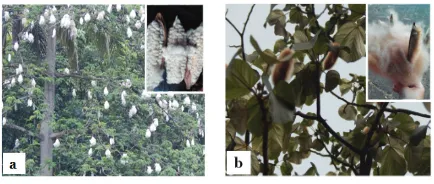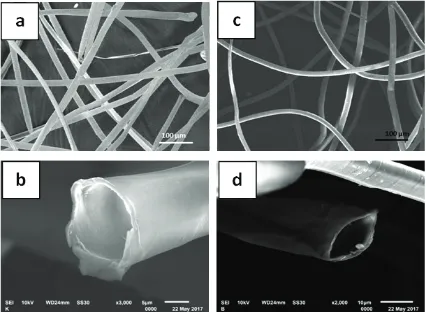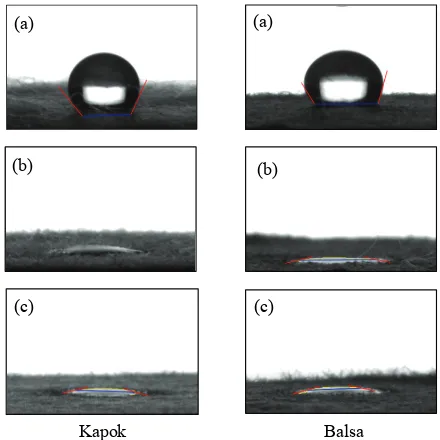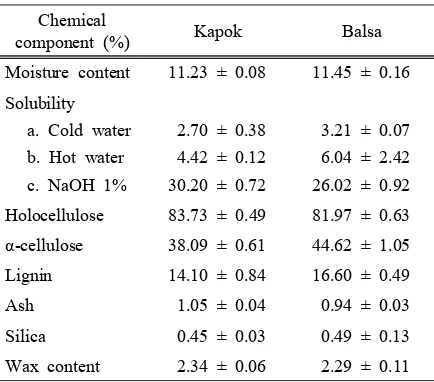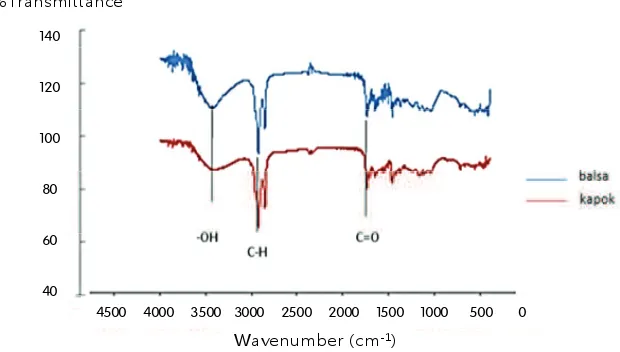2018
7
·
Determination of Moisture Index in Korea
Jong Bum Ra ����������������������������������������������������������������������������������������������������������������������������
Study on the Size Reduction Characteristics of Miscanthus sacchariflorus via Image Processing Hyoung-Woo Lee·Jae-Won Lee·Sung-Ho Gong·Yeon-Sang Song �����������������������������������������������
Morphological Characteristics of Bambusa vulgaris and the Distribution and Shape of Vascular Bundles therein
Atmawi Darwis·Apri Heri Iswanto ��������������������������������������������������������������������������������������������
Radial Variation in Selected Wood Properties of Indonesian Merkusii Pine
Wayan Darmawan·Dodi Nandika·Britty Datin Hasna Afaf·Istie Rahayu·Dumasari Lumongga ����
Measurement of Sound Transmission Loss in a Sound Barrier Filled with the Rice-Straw Particles by the Transfer Function and Laboratory Measurement Methods
Chun-Won Kang·Eun-Suk Jang·Sang-Sik Jang·Ho-Yang Kang ��������������������������������������������������
Radical Scavenging Activity of Kemenyan Resin Produced by an Indonesian Native Plant, Styrax sumatrana
Asep Hidayat·Apri Heri Iswanto·Arida Susilowati·Henti Hendalastuti Rachmat �����������������������
Effect of Different Pressing Processes and Density on Dimensional Stability and Mechanical Properties of Bamboo Fiber-based Composites
Ya-Hui Zhang·Yu-Xiang Huang·Hong-Xia Ma·Wen-Ji Yu·Yue Qi ��������������������������������������������� Comparison of Transfer Function Method and Reverberation Room Method in Measuring the
Sound Absorption Coefficient of Rice Straw Particle Mat
Chun-Won Kang·Eun-Suk Jang·Sang-Sik Jang·Ho-Yang Kang ��������������������������������������������������
Utilization of Saline Solutions in the Modification of Lignocellulose from Champaca Wood
Hanny F. Sangian·Muhammad Rifai Sehe·Gerald H. Tamuntuan·Zulnazri Zulnazri ������������������
A Two-stage Process for Increasing the Yield of Prebiotic-rich Extract from Pinus densiflora Ji Young Jung·Jae-Kyung Yang �������������������������������������������������������������������������������������������������
Physical and Chemical Properties of Kapok (Ceiba pentandra) and Balsa (Ochroma pyramidale) Fibers
Renny Purnawati·Fauzi Febrianto·I Nyoman J Wistara·Siti Nikmatin·Wahyu Hidayat·
Seung Hwan Lee·Nam Hun Kim �����������������������������������������������������������������������������������������������
Method of DNA Extraction from Pinus rigida Wood Pretreated with Sandpaper
Jamin Lee·Tae-Jong Kim ����������������������������������������������������������������������������������������������������������
Transformation of Terpene Synthase from Polyporus brumalis in Pichia pastoris for Recombinant Enzyme Production
Ji-Eun An·Su-Yeon Lee·Sun-Hwa Ryu·Myungkil Kim ���������������������������������������������������������������
July 2018
Vol. 46 No. 4 Vol. 46 No. 4 July 2018
Journal of the Korean Wood Science and Technology
Journal of the Korean Wood Science and Technology
The Korean Society of Wood Science & Technology
- II - I
Jour
nal of The Kor
ean W
ood Science and T
echnology
Vol. 46 No. 4
The Kor
ean Society of W
ood Science & T
Original Article
Physical and Chemical Properties of Kapok (
Ceiba pentandra
)
and Balsa (
Ochroma pyramidale
) Fibers
1
Renny Purnawati
2Fauzi Febrianto
2,†I Nyoman J Wistara
2Siti Nikmatin
3Wahyu Hidayat
4Seung Hwan Lee
5Nam Hun Kim
5,†ABSTRACT
1)Natural fibers derived from lignocellulosic materials are considered to be more environment-friendly than petroleum-based synthetic fibers. Several natural fibers, such as seedpod fibers, have a potential for development, including kapok and balsa fibers. The characteristics of both fibers were evaluated to determine their suitability for specific valuable applications. The purpose of this study was to analyze some important fundamental properties of kapok and balsa fibers, including their dimensions, morphology, chemical components, and wettability. The results showed that the average fiber lengths for kapok and balsa were 1.63 and 1.30 cm, respectively. Kapok and balsa fibers had thin cell walls and large lumens filled with air. The kapok fiber was composed of 38.09% α-cellulose, 14.09% lignin, and 2.34% wax content, whereas the balsa fiber was composed 44.62% α-cellulose, 16.60% lignin, and 2.29% wax content. The characteristics of kapok and balsa fibers were examined by X-ray diffraction, Fourier-transform infrared spectroscopy and differential scanning calorimetry analyses. The contact angle of the distilled water on kapok and balsa fibers was more than 90°, indicating that both fibers are hydrophobic with low wettability properties because of to the presence of wax on the fiber surface.
Keywords: balsa fiber, chemical compounds, fiber dimension, kapok fiber, morphology, relative crystallinity,
wettability
1. INTRODUCTION
Indonesia has a large amount of natural lignocellulosic fibers with potential use in a variety of industrial products based on available technology.
Despite some technological advancement, specific characteristics of the materials have become an important factor in developing new fiber-based products. Several natural fibers with the potential to be developed are fibers from the fruit of kapok (Ceiba
1Date Received May 17, 2018, Date Accepted July 9, 2018
2Department of Forest Products, Faculty of Forestry, Bogor Agricultural University, Indonesia
3Department of Physics, Faculty of Mathematics and Natural Science, Bogor Agricultural University, Indonesia 4Department of Forestry, Faculty of Agriculture, Lampung University, Indonesia
5Department of Forest Biomaterials Engineering, College of Forest and Environmental Science, Kangwon National University, Republic of Korea
Renny Purnawati Fauzi Febrianto I Nyoman J Wistara Siti Nikmatin Wahyu Hidayat Seung Hwan Lee Nam Hun Kim
pentandra) and balsa (Ochroma pyramidale); however, these fibers, especially balsa fibers, have not been thoroughly studied until now.
Indonesia is one of the world's biggest kapok exporters. Around 52,800 tons of kapok were produced from 143.7 ha of community plantations in Java (BPS, 2015). Meanwhile, balsa wood is one of the fast-growing species in Indonesian plantation forests, and the fibers from its fruits could add to the product value.
Balsa and kapok fibers have similar physical properties. Kapok trees are widely distributed in tropical areas. They are 60-70 m tall, their trunks expand to 3 m in diameter, and they have palm-shaped leaves. An adult kapok tree produces hundreds of seedpods with black seeds and yellow fibers. The extracted fibers are smooth and light; they are used in manufacturing pillows, life preservers, sleeping bags, and insulation. Moreover, kapok has also been investigated as an absorbent material for oil and acoustic insulation (Likon
et al., 2013; Wang et al., 2012; Rengasamy et al., 2011; Veerakumar and Selvakumar, 2010).
Balsa trees are fast-growing evergreen trees that can reach up to 30 m in height and 1.8 m in diameter at breast height. They typically have buttress roots. They have a reputation as the lightest commercial wood for various purposes. The silky fibers of its fruit can be used as a material for pillows, mattresses, and cushions. Nevertheless, there are no detailed studies previously reported on the basic properties of balsa fiber.
Kapok and balsa fibers as natural resources can potentially be developed for several applications (Purnawati et al., 2018). However, the characteristics of kapok and balsa fibers must be identified in order to determine their suitability for various applications and products. The purpose of this study was to analyze some important properties of kapok and balsa fibers, including their morphology, chemical composition, relative crystallinity, thermal properties, and wettability.
2. MATERIALS and METHODS
2.1. Materials
Kapok and balsa seedpods were obtained from the plant collection of Bogor Agricultural University, Dramaga, West Java (Fig. 1).
Fig. 1. Trees of kapok (a) and balsa (b) with their seedpods.
Kapok and balsa fibers were removed from their pods, separated from their seeds, and dried at room temperature (25 °C). The fibers were then ground to 40-60 mesh size for the purpose of chemical component analysis.
2.2. Methods
2.2.1. Microscopy
Kapok and balsa fibers were successively rinsed with 10%, 30%, and 50% aqueous ethanol. Then, the fibers were stained with 1% safranine solution for 24 h. Finally, they were rinsed with 50% ethanol to remove the excess dye. Fiber morphology was observed by digital photomicroscopy (Carton CB-10, Thailand) using a 5 MP USB eyepiece camera. Fiber dimensions (length, diameter, and cell wall thickness) were analyzed by FIJI ImageJ 1.51p software for Windows.
2.2.2. X-ray diffraction analysis
The relative crystallinity index (CrI) of the materials was tested using an X-ray diffractometer (XRD, Shimadzu XRD-7000 MaximaX series). A Ni-filtered CuKα X-ray operating at 40 kV and 30 mA was used to analyze the cellulose crystalline properties for both fibers. Relative crystallinity was calculated by the following formula (Segal et al., 1959):
CrI = [(I200 Iam/I200)] × 100, ··· (1)
where I200 is the maximum intensity of the lattice
diffraction of cellulose type I and Iam is the intensity
diffraction of the amorphous cellulose.
The size of the crystals (т) was calculated using the Scherrer equation (Smilgies, 2009) as follows:
Č
ŀ Ŧ
Analyzer (Surface Electro Optics, Korea) (Suryadi, 2017). Demineralized water and methanol were used as the polar liquids, and hexane was used as the non-polar liquid. The three-probe liquids were placed on the surface of the fiber. Each droplet was 5 μL in volume, and a total of three droplets were analyzed for each liquid. The contact angle measurement was performed by capturing a droplet image using Surfaceware 8 software and a camera-based contact angle analysis system. The process of capturing the image was continuously conducted at the beginningof the test, after 5 min, and after 10 min. The angles subjected to a temperature program; Shimadzu DSC-60 was operated in a dynamic mode in the temperature range of 30 °C to 500 °C and a heating rate of 10 °C/min in a nitrogen environment purged at 25 mL/min.
2.2.5. Chemical analysis
The chemical compositions, including extractives, ash, and lignin content, of kapok and balsa fibers were determined in accordance with the TAPPI standards (TAPPI T204 om-88, 1988; TAPPI T211 om-02, 2002; and TAPPI T222 om-88, 1988). The holocellulose (α
-cellulose + hemicellulose) content was estimated by the acid chloride method, and the α-cellulose content was determined by treating the holocellulose with a sodium hydroxide solution (Browning, 1967). Wax content was determined in accordance with the AATCC Test Method 97 (American Association of Textile Chemists and Colorists, 2012).
Renny Purnawati Fauzi Febrianto I Nyoman J Wistara Siti Nikmatin Wahyu Hidayat Seung Hwan Lee Nam Hun Kim
fibers had a hollow structure with a thin fiber wall and a large lumen filled with air (Fig. 2b and Fig. 2d). Single-cell seed fibers such as kapok, balsa, and cotton are different from other natural fibers such as wood, hemp, jute etc. Unicellular cellulosic fibers are typically oval- or cylindrical, are long with pointed ends, and have thin cell walls with large lumens, which led to low fiber densities for both kapok and balsa.
Meiwu et al. (2010) and Mwaikambo (2006) stated that kapok was the lightest fiber in the world. The apparent specific gravity of the Indian kapok fiber was approximately 0.0554, whereas that of Japanese kapok was approximately 0.0388. Moreover, kapok fiber was six times lighter than cotton (Mwaikambo, 2006). Meanwhile, cotton fiber had a density of 0.29 g/cm3 according to a study conducted by Meiwu et al. (2010). Balsa fiber had a light brown color, whereas kapok had a yellowish white color. Both fibers were luminous because of the wax content of the fiber surface, showing similarity to the silk fibers. Both fibers were about two times longer than non-timber lignocellulosic fibers, such as pineapple, corn, coconut, bagasse, banana, hay, and sorghum (Reddy and Yang, 2005). However, the kapok and balsa fiber lengths were shorter than those of cotton, hemp, and flax (Mwaikambo, 2006).
Parameters such as fiber length, diameter, and cell wall thickness of kapok and balsa are shown in Table 1. The length of the kapok fiber ranged from 13.79 to 18.84 mm, whereas that of balsa ranged from 10.36 to 15.70 mm. Kapok fibers were longer than balsa fibers, but their diameter and cell wall thickness were less than those of balsa fibers. Kapok fibers had an exceptional liquid-retention capability considering their large lumens. Their excellent thermal and acoustic insulating properties, high buoyancy, and good absorbency for oil and other non-polar liquids distinguish kapok from most other cellulosic fibers (Wang et al., 2012; Lim and Huang, 2007; Zheng et al., 2015). Balsa fibers may have similar properties because of their similar morphology.
Fig. 2. SEM images of the kapok fiber (a and b) and balsa fiber (c and d).
Dimension Kapok Balsa
Length (mm) 16.32 ± 2.54 13.01 ± 2.69
Width (µm) 17.59 ± 3.72 19.25 ± 2.69
Cell wall thickness
(µm) 1.34 ± 0.77 2.40 ± 0.97
Table 1. Dimensions of kapok and balsa fibers
3.2. X-ray diffraction analysis
Fig. 3 shows X-ray diffractograms that display peaks of 2θ= 22.15° in kapok fibers and 22.31° in balsa fibers, which are characteristic of cellulose type I crystals. The crystallinity index (CrI) of the kapok fiber was 35.65%, and that of balsa fiber was 31.40%. According to Poletto et al. (2014), the CrI for both fiber types was similar to the values for jute (34.3%), kenaf (34.9%), and ramie (34.8%).
Fiber type Time (min) Contact angle (°)
Water Methanol Hexane
Kapok 0 120.74 ± 1.45 12.33 ± 0.30 12.67 ± 0.35
5 117.24 ± 0.32 0 0
10 113.12 ± 0.20 0 0
Balsa 0 109.98 ± 1.51 11.81 ± 0.08 11.88 ± 0.04
5 104.46 ± 1.58 0 0
10 102.82 ± 0.13 0 0
Table 3. Contact angles of liquids tested on the fiber surface
(a) (a)
(b) (b)
(c) (c)
Kapok Balsa
Fig. 4. Contact angle for kapok and balsa fibers with three test liquids: (a) water, (b) methanol, and (c) hexane.
Variable Kapok Balsa
Relative crystallinity (%) 35.65 31.40
Crystallite width (nm) 4.70 3.70
Table 2. Crystalline characteristics of kapok and balsa fibers
Table 2 presents the crystallinity index (%) and the crystallite width for kapok and balsa fibers. The crystal widths of both fibers were larger than those of kenaf (Lee et al., 2008) and wood cellulose (Eun et al., 2008).
3.3. Wettability
The contact angles for the three types of liquid tested (water, methanol, and hexane) on kapok and balsa fibers after 0, 5, and 10 min following the droplet deposition are presented in Table 3.
The study of wettability uses contact angle measure-ments which simulate the degree of wetting during the interaction between solids and liquids. A small contact angle (<90°) refers to high wettability, whereas a large contact angle (>90°) refers to a low wettability.
Table 3 shows that the contact angle of water with kapok fiber was higher than that with balsa fiber. This phenomenon indicated a lower wettability for kapok fiber than that for balsa fiber. The larger the contact angle, the longer the liquid would stay above the fiber surface (i.e., low wettability). The other two test liquids, methanol and hexane, formed very small contact angles
(Fig. 4) and exhibited much lower surface energies than water.
Renny Purnawati Fauzi Febrianto I Nyoman J Wistara Siti Nikmatin Wahyu Hidayat
polymers that have various surface energies.
3.4. Analysis of thermal properties
The DSC technique can be used to determine a drop in crystallinity and decomposition of plant fiber cellulose (Mwaikambo and Ansell 2002). There are three types of weight/mass loss during thermal degradation: water removal (drying), organic matter release (devolatilization), and bonded-carbon oxidation (slow combustion). From the DSC results, kapok and (2010), hemicellulosic depolymerization might occur at a temperature of 180 °C 340 °C, and breakage of the cellulosic glycosidic bond might occur at 275 °C
350 °C (Poletto et al., 2012).
The third peak expressed the final decomposition
Wavenumber (cm-1)
4500 4000 3500 3000 2500 2000 1500 1000 500 0
%Transmittance
140
120
100
80
60
40
Fig. 6. FTIR spectra of kapok (red) and balsa (blue) fibers.
from 82% to 96%, with a lignin content of 0% 5% (Mwaikambo, 2006).
Previous studies on the chemical components of kapok stated that its fiber contained a large amount of organic lignin at 15% 22%, 35% 50% of cellulose, 22% 45% of hemicellulose, and 2% 3% of wax. It also contained small amounts of starch, approximately 2.1% of protein, and some inorganic substances, notably iron content of 1.3% 2.5% (Smole
et al., 2013). Considering the content of α-cellulose, kapok was more similar to wood than flax and other plant fibers (Fengel, 1986).
3.6. Functional group characterization
The FTIR spectra of kapok and balsa fibers are shown in Fig. 6. There were similar absorption bands for both fibers. An -OH functional group appeared at a wavenumber of 3356 cm-1 for kapok fiber and at 3425 cm-1 for balsa fiber, and C-H stretching was found at a wavenumber of 2916 cm-1 for kapok fiber and at 2908 cm-1 for balsa fiber. Both functional groups of -OH and C-H at these wavenumbers indicated the presence of cellulose, hemicellulose, and lignin (Moran
et al. 2008). Meanwhile, the carbonyl group (C=O)
found at 1736 cm-1 indicated the presence of hemicellulose (Chandrabakty, 2014).
The absorption peak at 1250 cm-1 for both fibers was associated with stretching of the aryl-alkyl ether group in lignin (Nazir et al., 2013). Meanwhile, the characteristic band located at 1034 cm-1 for balsa fiber and 1049 cm-1 for kapok fiber indicated the vibration of C-O-C or C-O in cellulose (Solikhin et al., 2016).
4. CONCLUSION
Renny Purnawati Fauzi Febrianto I Nyoman J Wistara Siti Nikmatin Wahyu Hidayat Seung Hwan Lee Nam Hun Kim
ACKNOWLEDGMENT
Authors acknowledge the support from the Ministry of Research, Technology and Higher Education of the Republic of Indonesia for funding this research through the International Research Collaboration and Scientific Publication scheme in 2017.
REFERENCES
American Association of Textile Chemists and Colorists. 2012. AATCC Test Method 97. Extractable content of textiles. United States: AATCC Technical Manual.
Browning, B.L. 1967. Methods of Wood Chemistry. Volume 2. New York: Interscience Publishing. Central Bureau of Statistics Republic of Indonesia
(BPS). 2015. Area and production of community forest plantation by species (2000 2015). Jakarta (ID): Central Bureau of Statistics
Chandrabakty, S. 2014. Fourier transform infrared (FT-IR) spectroscopy and tensile strength of melinjo’s stem bark using modification of Weibull distribution. Jurnal Mekanikal (5): 434 442. Eun, D.J., Kwon, S.M., Kim, N.H. 2008. Variation of Chemical Investigation. Holzforschung 40: 325 330.
Gaan, S., Rupper, P., Salimova, V. 2009. Thermal decomposition and burning behavior of cellulose treated with ethyl ester phosphoramides: effect of alkyl substituent on nitrogen atom. Polymer Degradation and Stability 4(7): 1025 1134. Jin, LG., Wu, S.B., Lou, R. 2010. Kinetic study of
the thermal decomposition of hemicellulose isolated
from corn stalk. Bioresources 5(2): 1281 1291. Lee, S.H, Kwon, S.M., Um, G.J., Kim, N.H. 2008.
Anatomical characteristics of kenaf grown in reclaimed land. Journal of the Korean Wood Science and Technology 36(4): 11 18.
Likon, M., Remskar, M., Ducman, V., Svegl, F. 2013. Populus seed fibers as a natural source for production of oil super absorbents. Journal Environmental Management. 114:158 167.
Lim, T.T., Huang, X. 2007. Evaluation of kapok (Ceiba pentandra (L.) Gaertn.) as a natural hollow hydrophobic oleophilic fibrous sorbent for oil spill cleanup. Chemosphere 66: 955 963.
Mani, G.K., Rayappan, J.B.B., Bisoyi, D.K. 2012. Synthesis and characterization of kapok fiber and its composites. Journal of Applied Science 12: 1661 nanocellulose from sisal fibers. Cellulose (15): 149 159.
Mwaikambo, L.Y. 2006. Review of the history, properties, and application of plant fibres. African Journal of Science and Technology 7: 120 133. Mwaikambo, L.Y., Ansell, M.P. 2002. Chemical
modification of hemp, sisal, jute, and kapok fibers by alkalization. Journal of Applied Polymer Science 84: 2222 2234.
Nazir, M.S., Wahjoedi, B.A., Yussof, A.W., Abdullah, M.A. 2013. Eco-Friendly Extraction and Characterization of Cellulose from Oil Palm Empty Fruit Bunches. Bioresources 8(2): 2161-2172. Njobuenwu, D.O., Oboho, E.O., Gumus, R.H. 2007.
Technologies 6(10): 29 38.
Poletto, M., Zattera, A.J., Forte, M., Santana, R. 2012. Thermal decomposition of wood: influence of wood components and cellulose crystallite size. Bioresource Technology 109: 148 153.
Poletto, M., Ornaghi, H.L., Zattera, A.J. 2014. Native cellulose: structure, characterization, and thermal properties. Materials 7: 6105 6119.
Purnawati, R., Febrianto, F., Wistara, N.J., Nikmatin, S., Sudirman, Marwanto, Kim, N.H. 2018. Alkaline treated-kapok and balsa fibers for composite reinforcement. JITKT 16(1): 21 31.
Reddy, N., Yang, Y. 2004. Biofibers from agricultural byproducts for industrial applications. Trends in Biotechnology 23: 22 27.
Rengasamy, R.S., Das, D., Karan, C.P. 2011. Study of oil sorption behavior of filled and structured fiber assemblies made from polypropylene, kapok, and milkweed fibers. Journal of Hazardous Materials 186: 526 532.
Schellbach, S.L., Monteiro, S.N., Drelich, J.W. 2015. A novel method for contact angle measurements on natural fibers. Material Letters 164: 599 604. Segal, L., Creely, J.J., Martin, A.E., Conrad, C.M. 1959.
An empirical method for estimating the degree of crystallinity of native cellulose using X-ray diffractometer. Textile Research Journal 29(10): 786 794.
Smilgies, D.M. 2009. Scherrer grain size analysis adapted to grazing-incidence scattering with area detectors. Journal Applied Crystallography 42(6): 1030 1034.
Smole, M.S., Hribernik, S., Kleinschek, K.S., Kreže, T. 2013. Plant Fibers for Textile and Technical
Applications. Chapter 15. InTech Open. http://dx.doi.org/10.57772/52372
Solikhin, A., Hadi, Y.S., Massijaya, M.Y., Nikmatin, S. 2016. Basic properties of oven-heat treated oil palm empty fruit bunch stalk fibers. Bioresources 11(1): 2224 2237.
Suryadi, G.S. 2017. Studies of microstructure, thermal, mechanics, and surface properties of oil palm empty fruit bunches reinforced biocomposites. Thesis. Graduate School of Bogor Agricultural University (IPB), Bogor Indonesia.
Technical Association of the Pulp and Paper Industry. 1988. TAPPI T204 om-88. Solvent extractives of wood and pulp. Atlanta: TAPPI Press.
Technical Association of the Pulp and Paper Industry. 2002. TAPPI T211 om-02. Ash in wood, pulp, paper, and paperboard: combustion at 525 °C. Atlanta: TAPPI Press.
Technical Association of the Pulp and Paper Industry. 1988. TAPPI T222 om-88. Acid-insoluble lignin in wood and pulp. Atlanta: TAPPI Press. Veerakumar, A., Selvakumar, N. 2012. A preliminary
investigation on kapok/polypropylene nonwoven composite for sound absorption. Indian Journal of Fibre and Textile Research (37): 385 388. Wang, J., Zheng, Y., Wang, A. 2012. Super hydrophobic
kapok fiber oil-absorbent: preparation and high oil absorbency. Chemical Engineering Journal 213: 1 7.
